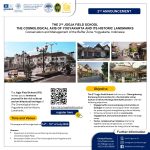 BFS 2005 focused on Klipoh and the assignment was to develop village design guidelines.
BFS 2005 focused on Klipoh and the assignment was to develop village design guidelines.
Participants were divided into three groups, each with a different theme:
• Water analysis of klipoh river
• Klipoh hamlet
• Region, scale, and façade of klipoh.
Water analysis of klipoh river
Mr Hashimoto proposed the need to purify the Klipoh River. When he analyzed the river he found problems such as stone mining and bamboo cutting and a lack of respect for the river, problems that led to dirty water (with solid and liquid waste), flooding in the rainy season, very little water in the dry season, and landslide erosion.
To achieve the objectives of flood control, useful water, and improved waterfront views, three sectors need to be involved in the purification activity:
- universities – to provide information, surveys, and education in the form of technical information, water quality monitoring, and workshops to educate the people
- local people – to renew the memory of past times (playing, swimming, and fishing in the river), remember the former water quality, find and consider nicknames of places, and learn from folk tales/legends
- government – to regulate a more environment friendly use, clean the river regularly, prevent vandalism to the river, and set guidelines.Klipoh hamlet
Klipoh hamlet
Klipoh hamlet in Karanganyar village has long been renowned for its pottery. Usually these crafts products are used as daily household equipment like kendil (for holding food), tempayan minum (for drinking), kuali gerabah (for cooking), and other uses.
According to folklore the pottery village has been around for centuries and has a connection with the construction of Borobudur Temple (according to the stories, the builders used Karanganyar pottery). It is located at the foot of the Menoreh Hills approximately five kilometers from Borobudur Temple. Karanganyar village shares borders to the north with Karangrejo village, east with Tanjungsari village, south with Giritengah village, and west with Ngadiharjo village. It covers an area of 156.52 square kilometers and has a population of about 1872 people, consisting of 426 families.
Region, scale and façade
Klipoh is a unique hamlet in the mosaic of the Borobudur area and plays an important role in Borobudur cultural landscape heritage. As one of villages in Borobudur, Klipoh is still remain traditional eventhough there are many changes and effects forced local value to be changed. But if we look in detail, there are still some traditional values and some were already changed. They changed from ordinary living to become pottery production house. Klipoh needs to be conserved and sustained.
Participants of 2nd BFS, 2005
Dimas Wihardyanto
Granita Zulaycha
Isamu Takama
Indah Sulistiana
Maria Carmelia
Nicolas Zaegel
Niswatul Azizah
Natsuji Hashimoto
Raditya Jati
Satrio Utomo Dradjat
Seika Oishi
Sinta Carolina
Tomoko Miyagawa
Tomoki Motozuka
Titin Fatimah
Winarni
Yosuke Sato
Yumi Kanki (Terakawa)



